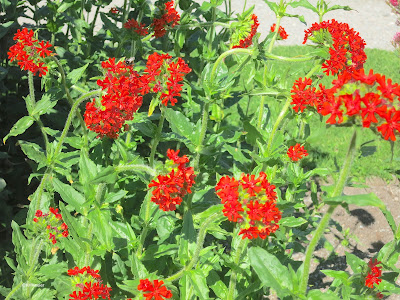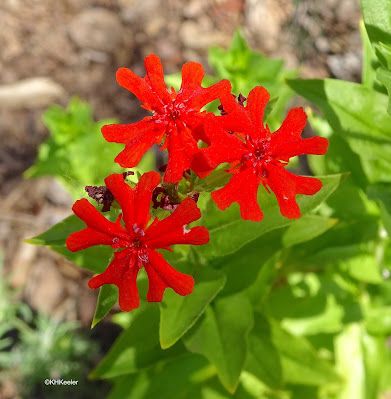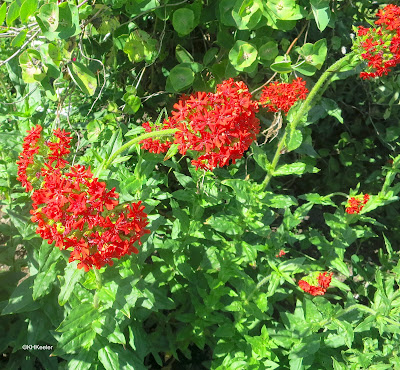Maltese cross is a handsome red garden flower, easy to remember once you have noticed it. I learned it as Lychnis chalcedonica but properly it is Silene chalcedonica, although you can find it called Lychnis in many places still.
 |
| Maltese cross, Silene chalcedonica |
It is called Maltese cross because the shape of a Maltese cross (link) IF you are willing to ignore the fact that crosses have four arms and the plant, being a member of the dicotyledonous Pink Family, Caryophyllaceae, has five petals, as in my photographs.
This striking flower is native to Eurasia, from central Russia to western China. It was brought to Europe as a cultivated plant in the Middle Ages and carried from there to North America. It has escaped and naturalized across most of the northern United States and southern Canada, but not as far west as Colorado, so while some places in the North America you can encounter it in the wild, I see it only in gardens.
Relatively long-lived, two to three feet tall with bright red flowers, resistant to deer and rabbits, it became a British garden favorite and a classic part of cottage garden flowers. It received the British Horticultural Society's Award of Garden Merit in 1993 an honor recognizing its beauty and that it is is well-behaved under British garden conditions.
Maltese cross has a very long list of common names, Jerusalem cross, scarlet lychnis, scarlet campion, rose campion (which confuses it with another Silene), flower of Bristol, nonesuch, burning love, fireball, flower of Constantinople, gardener's delight, red robin, tears of Christ...the list goes on.
Flower of Bristol is a widely used common name because the city of Bristol (U.K.) has made the flower their own since at least 1600. Folklore says a crusader brought the flower to Bristol or, alternately, it came from a trading ship from the East. The city's arms have a lot of red, which the flower of Bristol reflects. Furthermore, in the 1600s John Whitson, councilman, mayor, and member of Parliament, having lost his daughters, to him the flowers of Bristol, founded and funded the Red Maids School, a school for girls. Still in existence today, it is the oldest such institution in England. Whitson ordered that the girls would wear red, a rare and expensive color in the early 1600s, and they still do. Stories about the school imply that the flower of Bristol produced a red dye used for the girls' clothes. Flowers very rarely make lasting dyes and I can find no confirmation that Maltese cross flowers produce dyes, so I conclude that Bristol simply fell in love with Maltese cross, making it the flower of Bristol, growing it wherever they could and using it to represent them.
 |
| the flower of Bristol, Silene chalcedonica |
This same relation to red dyes is the source of nonesuch as a common name of Maltese cross. Nonesuch refers to the deep red color in the Red Maids School uniforms, a color so fine that there was none such as good. Since Maltese cross is that color, it is nonesuch too. Again the implication that Maltese cross was the dye plant. I doubt it, but will test it as soon as possible, next summer, alas.
 | |
| maltese cross, Silene chalcedonica |
Maltese cross is protected by saponins, compounds like those in soap which bind to protein, so it is not very palatable--and toxic in large quantities--to humans, deer, and rabbits, but not powerful enough to have been used as a medicinal plant.
Being intensely red with accessible nectar and pollen, it attracts a wide variety of pollinators.
Maltese cross, flower of Bristol, call it what you like, its a handsome garden flower.
Comments and corrections welcome.
References
Red Maids School home page link Accessed 11/3/23.
UBCC Alumni. The Flower of Bristol link Accessed 11/3/23
Plant Lore Maltese cross. link Accessed 11/3/23


Very interesting. Thank you.
ReplyDelete